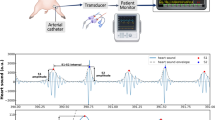Abstract
A method is proposed for noninvasive assessment of the pulmonary artery pressure based on separation of the aortic and pulmonary components of the second heart sound S2 and determining the delay time between them. The algorithm for separating the aortic and pulmonary components is based on the Wigner–Ville transform. Analysis of the phonocardiograms of 96 patients with pulmonary hypertension (PH) recorded by doctors of the Scientific Research Center of Cardiology using an original set of equipment was carried out. In 53 patients with PH, it was possible to separate S2 signals into components and determine the delays between them. We construct the dependence of delays between the components on pulmonary artery pressure (PAP), measured by right heart catheterization (RHC). For seven patients with PH, the obtained dependences were used to predict the PAP value from the measured time delay. For five patients, the determination coefficient for the predicted PAP values was 0.83, which indicates a fairly good correlation with measurements by the RHC method.



Similar content being viewed by others
REFERENCES
R. Zamanian, A. B. Waxman, and B. A. Maron, Pulmonary Hypertension: Basic Science to Clinical Medicine (Springer, 2015), p. 371.
N. B. Shiller and M. A. Osipov, Clinical Echocardiography (Praktika, Moscow, 2005) [in Russian].
V. A. Almazov, A. G. Salim’yanova, and E. V. Shlyakhto, Heart Auscultation (Pavlov Saint Petersburg State Medical University, St. Petersburg, 1996) [in Russian].
D. L. Sikarskie, P. D. Stein, and M. Vable, in Mathematical Modelling in Science and Technology (Pergamon, 1984), p. 709.
V. G. Andreev, V. V. Gramovich, O. N. Vyborov, T. V. Martynyuk, O. V. Rodnenkov, and O. V. Rudenko, Akust. Zh. 65 (2), 232 (2019).
V. G. Andreev, V. V. Gramovich, O. N. Vyborov, T. V. Martynyuk, O. V. Rodnenkov, and O. V. Rudenko, Acoust. Phys. 65 (6), 765 (2019).
J. Xu, L.-G. Durand, and P. Pibarot, IEEE Trans. Biomed. Eng. 47 (10), 1328 (2000).
J. Xu, L.-G. Durand, and P. Pibarot, IEEE Trans. Biomed. Eng. 48 (3), 277 (2001).
J. B. Allen and L. R. Rabiner, Proc. IEEE 65 (11), 1558 (1977).
S. M. Debbal and F. Bereksi-Reguig, Comput. Biol. Med. 37, 269 (2007).
W. Mecklenbräuker and F. Hlawatsch, The Wigner Distribution: Theory and Applications in Signal Processing (Elsevier Science, 1997), p. 480.
A. Djebbari and F. Bereksi-Reguig, BioMed. Eng. OnLine 12, 37 (2013). https://doi.org/10.1186/1475-925X-12-37
M. V. Lesik, A. I. Korol’kov, and V. G. Andreev, Uch. Zap. Fiz. Fak. Mosk. Univ., No. 4, 1840703 (2018).
S. Barma, B. Chen, K. L. Man, and J. Wang, IEEE/ACM Trans. Comput. Biol. Bioinf. 12 (4), 851 (2015).
Funding
The study was financially supported by the Russian Foundation for Basic Research, (grant no. 18-02-00736).
Author information
Authors and Affiliations
Corresponding author
Rights and permissions
About this article
Cite this article
Andreev, V.G., Gramovich, V.V., Krasikova, M.V. et al. Time–Frequency Analysis of The Second Heart Sound to Assess Pulmonary Artery Pressure. Acoust. Phys. 66, 542–547 (2020). https://doi.org/10.1134/S1063771020050012
Received:
Revised:
Accepted:
Published:
Issue Date:
DOI: https://doi.org/10.1134/S1063771020050012




